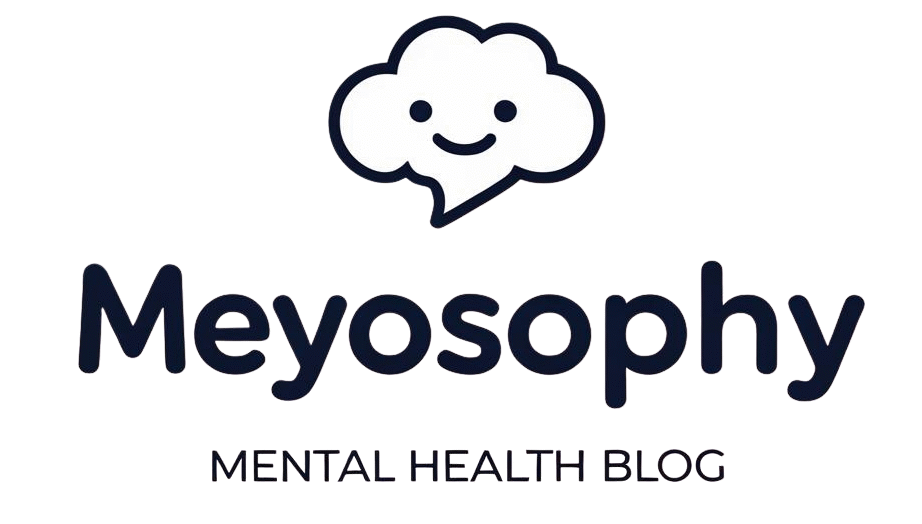Most of us were never taught how to understand what we feel. We learned math, grammar, and maybe how to write an essay, but not how to sit with sadness, anger, or fear. So when emotions show up as tightness in the chest, tears out of nowhere, or complete numbness, it can feel confusing or even scary.
If you often say “I don’t know how I feel”, you’re not alone. And you can learn to name and understand your emotions again, one gentle step at a time.
Disclaimer: This article is for educational and self-reflective purposes only and is not a substitute for professional mental health care. Everyone’s emotional experience is unique, and what helps one person may not help another. If you’re struggling to cope with intense emotions, persistent sadness, anxiety, or numbness, consider reaching out to a licensed therapist or counselor.
If you ever feel unsafe with your thoughts or emotions, please reach out for immediate support through local emergency services or an international helpline such as findahelpline.com, which lists free and confidential options in your country. You don’t have to go through it alone.
Why It’s So Hard to Know What You Feel
In a world that rewards productivity and logic, emotions are often seen as inconvenient. Many of us grew up hearing things like “Don’t cry,” or “You’re too sensitive.” Over time, that teaches your brain to turn the emotional volume down.
Stress, trauma, depression, and anxiety can make this even harder.
When your nervous system is overloaded, emotions either flood you or shut off completely, a kind of internal survival switch. So if you feel numb, detached, or disconnected, that’s not failure. It’s your body protecting you from overwhelm.
But the truth is: emotions are information. They tell you what you need, what matters to you, and where your boundaries are. Reconnecting with them is how you reconnect with yourself.
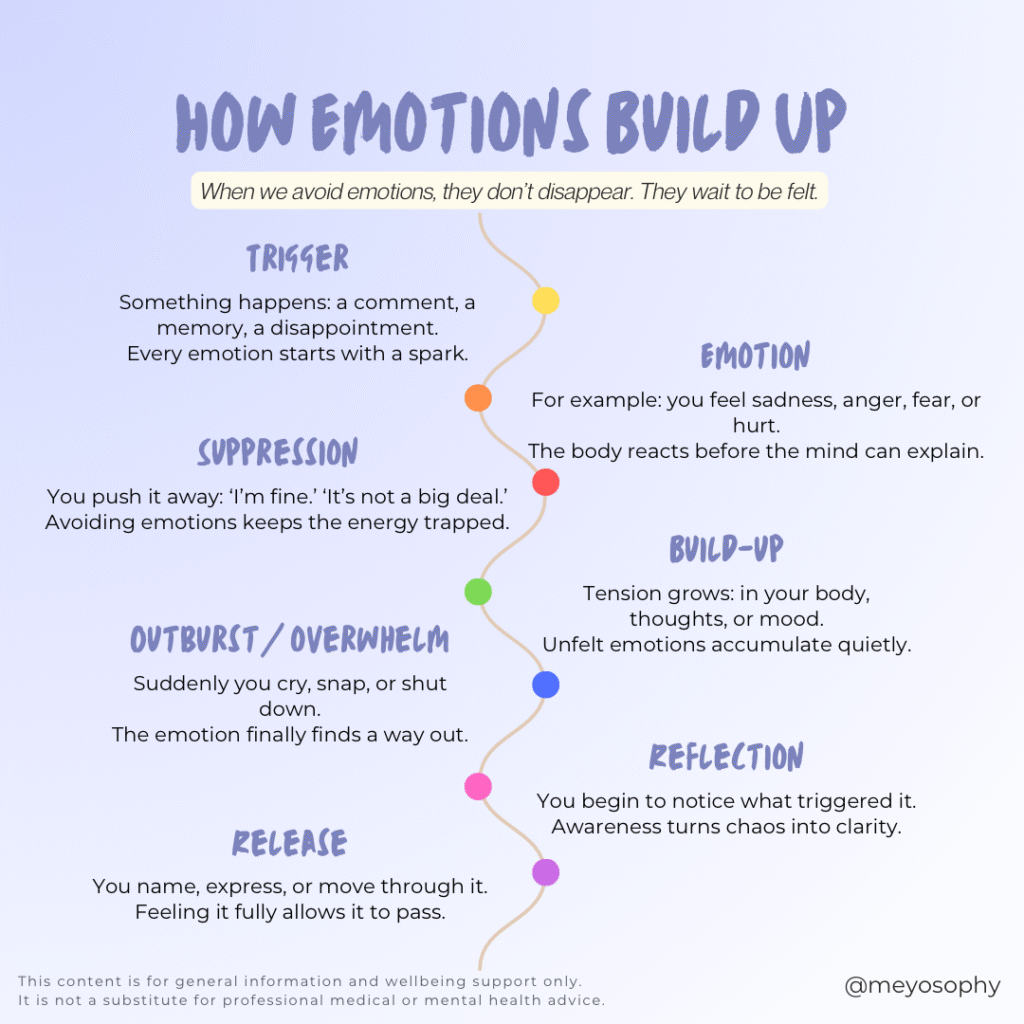
What Emotions Really Are
Emotions aren’t just “in your head.” They start in the body.
They’re physical reactions to your thoughts, surroundings, and experiences: a blend of hormones, brain activity, and nervous system signals that send messages like:
- “You’re in danger” (fear)
- “Something’s unfair” (anger)
- “You lost something important” (sadness)
- “You need connection” (loneliness)
When you name what you feel, you help your brain make sense of that body signal. This simple act activates the rational part of the brain (the prefrontal cortex) and soothes the emotional centers. Scientists call this “affect labeling”. Naming emotions to reduce their intensity and create calm.[1]
So in a very real way, naming emotions helps regulate them.
Why Naming Your Emotions Matters
Think of emotions like the dashboard lights in your car.
If you ignore them, the system overheats.
If you acknowledge them, you can take care of what’s underneath.
Naming your emotions helps you:
- Reduce overwhelm and panic.
- Understand your triggers and needs.
- Communicate more clearly with others.
- Build emotional resilience over time.
Even a simple phrase like “I feel angry and disappointed right now” can make your body relax a little. It’s a way of telling yourself: “I see what’s happening. I’m listening.”
Why It’s Hard to Identify Feelings
If you struggle to name emotions, you’re not alone.
There are a few common reasons this happens:
- Emotional suppression: you were taught not to show or feel emotions.
- Overwhelm: you feel so much that everything blends together.
- Depression: flattens emotional range, leaving you numb or empty.
- Anxiety: floods the system so fast it’s hard to label what’s happening.
- Derealization or depersonalization: you feel disconnected from your body or reality, making emotions hard to access.
- Trauma: can make certain emotions feel unsafe or “off-limits.”
Understanding why it’s hard is the first step in making it easier.
Finding Your Window of Tolerance
When it comes to emotions, your nervous system is the stage they play on.
If the body feels unsafe or overwhelmed, it becomes harder to name or process what you feel, no matter how self-aware you are.
The window of tolerance is the range where your mind and body can handle emotions without becoming flooded or shut down. Inside this window, you can feel sadness, anger, or fear and still think clearly enough to respond with care instead of reacting impulsively.
When You’re Outside the Window
When emotions feel too big, your system may go into:
- Hyperarousal: anxiety, racing thoughts, irritability, panic.
You might feel like everything’s “too much.” - Hypoarousal: numbness, emptiness, shutdown.
You might feel nothing at all, like you’re watching life from a distance.
Both are normal responses to stress or unprocessed emotion. They’re not “failures”, they’re signs your body is asking for regulation before reflection.

The Link Between Emotions and Mental Health Disorders
Emotions are at the heart of our mental health. When we regularly suppress, ignore, or misinterpret what we feel, those unprocessed emotions can begin to show up as symptoms of anxiety, depression, or chronic stress. For example, long-term sadness that isn’t expressed can deepen into hopelessness; unacknowledged anger can turn inward as guilt or self-criticism; and emotional numbness often appears when the nervous system has been overwhelmed for too long. Learning to recognize and name your emotions helps prevent that buildup. It gives your feelings a healthy outlet and helps your body return to balance. Emotional awareness isn’t just self-help; it’s a form of early intervention for your mental health.
Getting to Know Your Emotions: Beyond the Basics
Most people can name about four emotions: happy, sad, angry, and scared.
But the human emotional landscape is much bigger. Learning to tell emotions apart helps you understand what your mind and body are truly trying to say.
Below are eight main families of emotions, with examples, what they mean, and what they might be asking for. You don’t have to memorize them, just start noticing which ones show up most in your life.
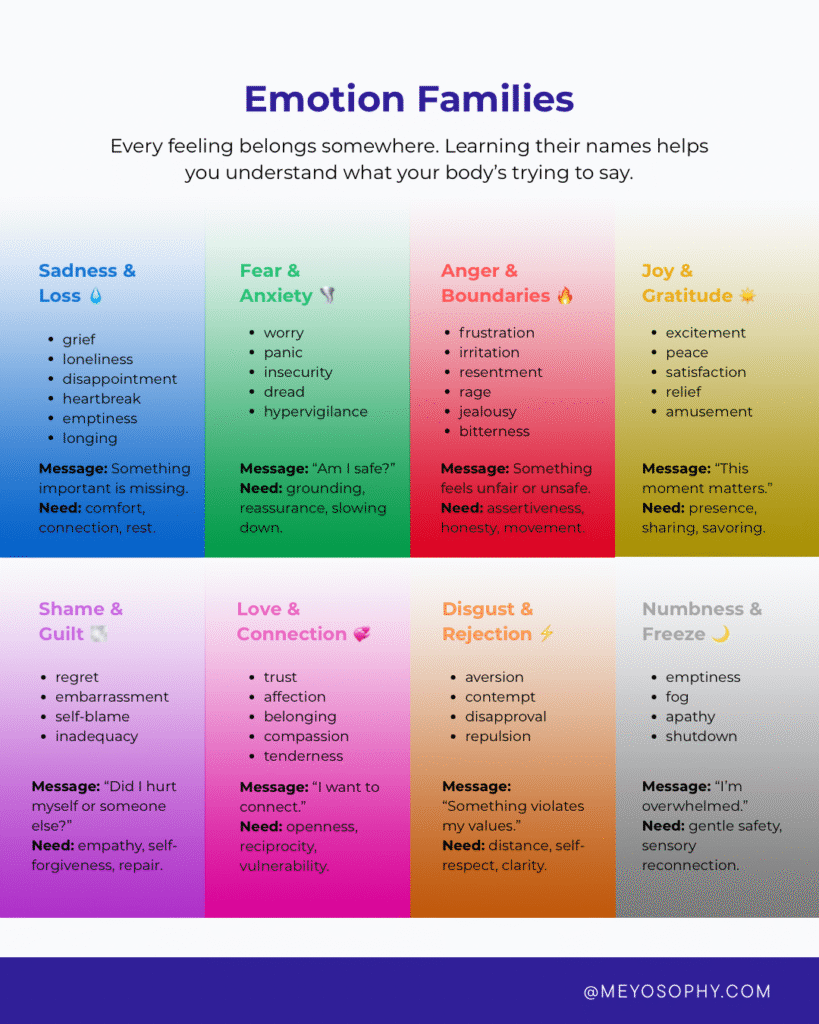
😔 Sadness and Loss
Examples: sadness, grief, heartbreak, loneliness, disappointment, hopelessness, emptiness, longing.
What it means: Sadness tells us that something (or someone) mattered. It signals loss, unmet needs, or disconnection. It’s not a weakness, it’s love showing up in a different form.
What it needs: comfort, rest, expression (tears, talking, journaling), and time.
Suppressing sadness often turns it into numbness or fatigue. Letting yourself feel it gently helps healing.
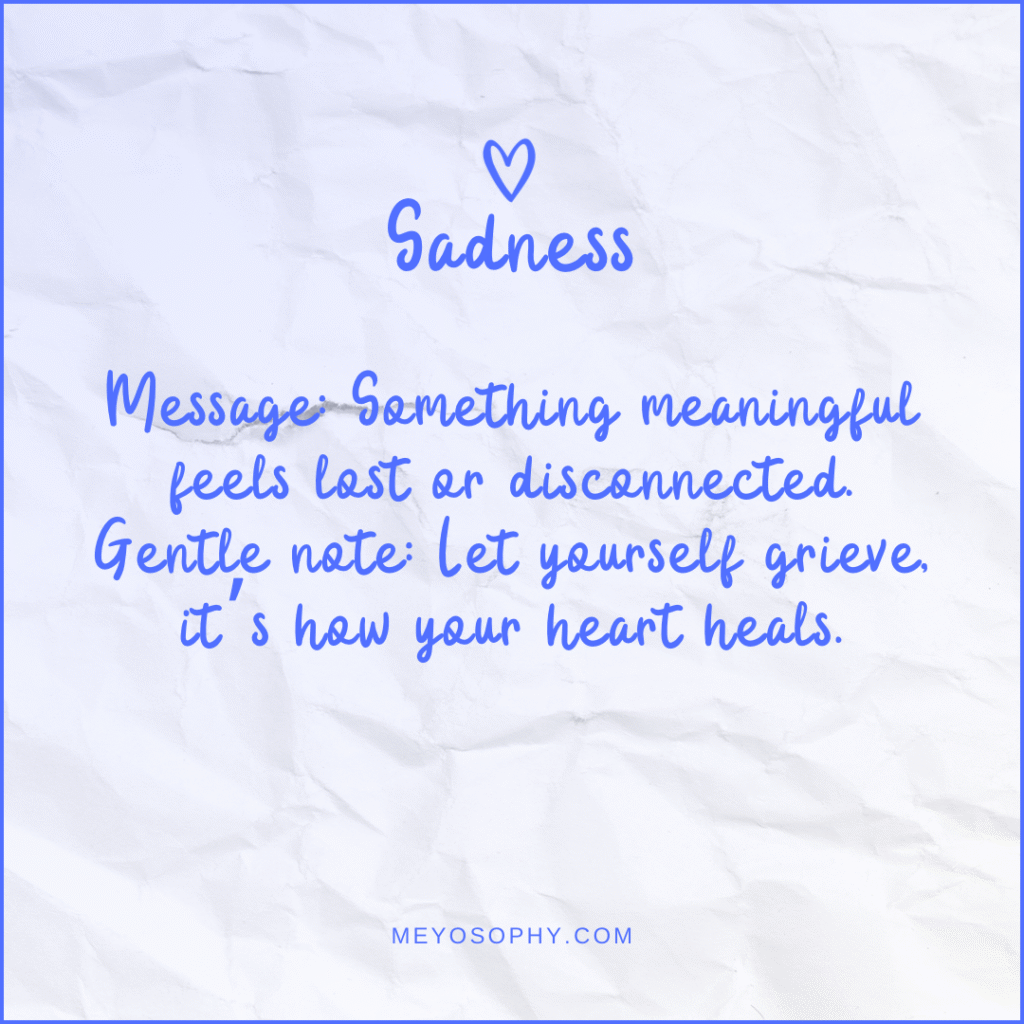
😠 Anger and Boundaries
Examples: anger, irritation, frustration, resentment, jealousy, rage, bitterness, injustice, betrayal.
What it means: Anger protects you. It points to crossed boundaries, unfair treatment, or unmet expectations. It’s your system saying, “Something isn’t right here.”
What it needs: recognition and direction. Anger isn’t meant to explode or be swallowed. It’s meant to guide you toward change, assertiveness, or protection. Calm expression (writing, moving, speaking truthfully) helps transform anger into clarity. Investigate why you’re feeling angry and express or take action in a healthy way.
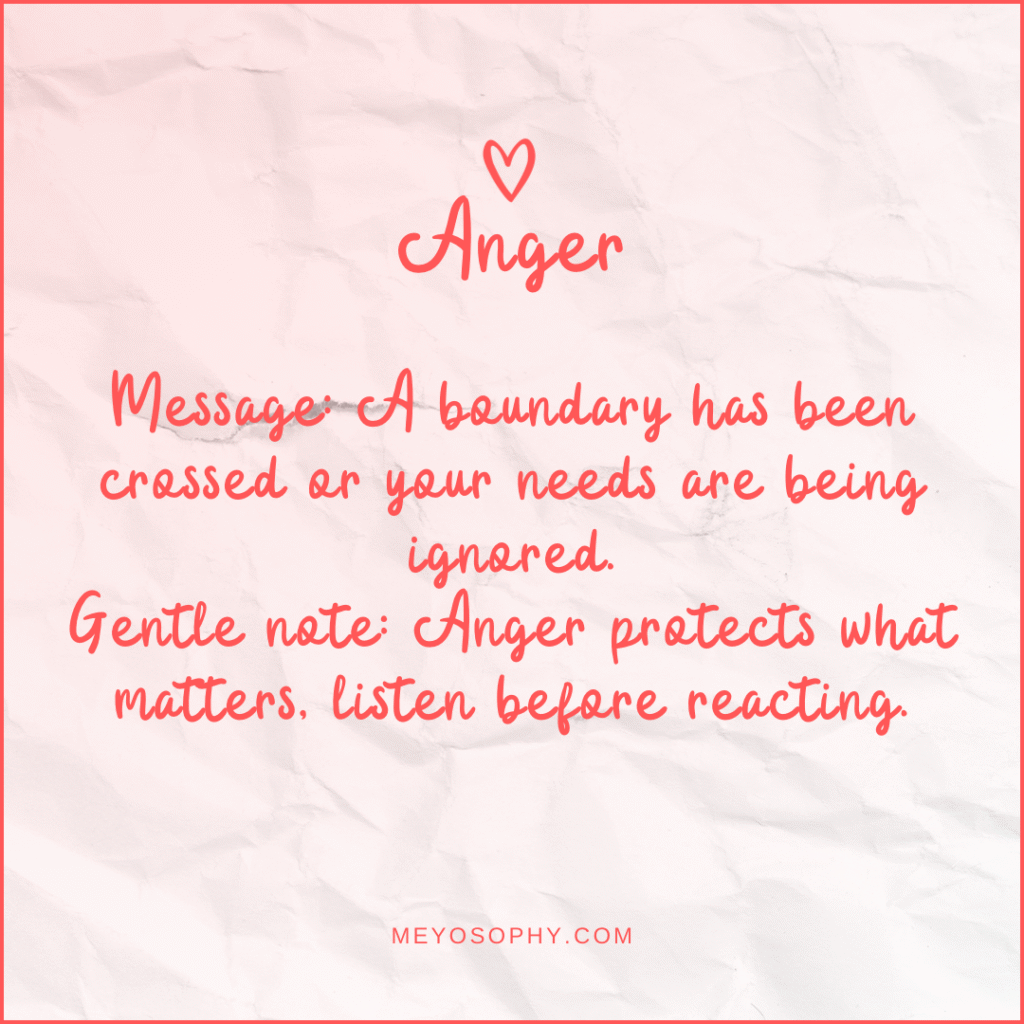
😨 Fear and Anxiety
Examples: fear, worry, anxiety, dread, panic, insecurity, nervousness, terror, vigilance.
What it means: Fear is your brain’s alarm system. Sometimes it’s accurate (there is danger); sometimes it’s overprotective (imagined danger). Anxiety can linger even when you’re safe, it’s fear stuck in “on” mode.
What it needs: grounding, reassurance, and safety.
Slow breathing, movement, and soothing self-talk (“I’m safe right now”) calm the nervous system. Avoiding fear keeps it alive; facing it gently teaches your body that it can handle discomfort (unless it’s actually unsafe).
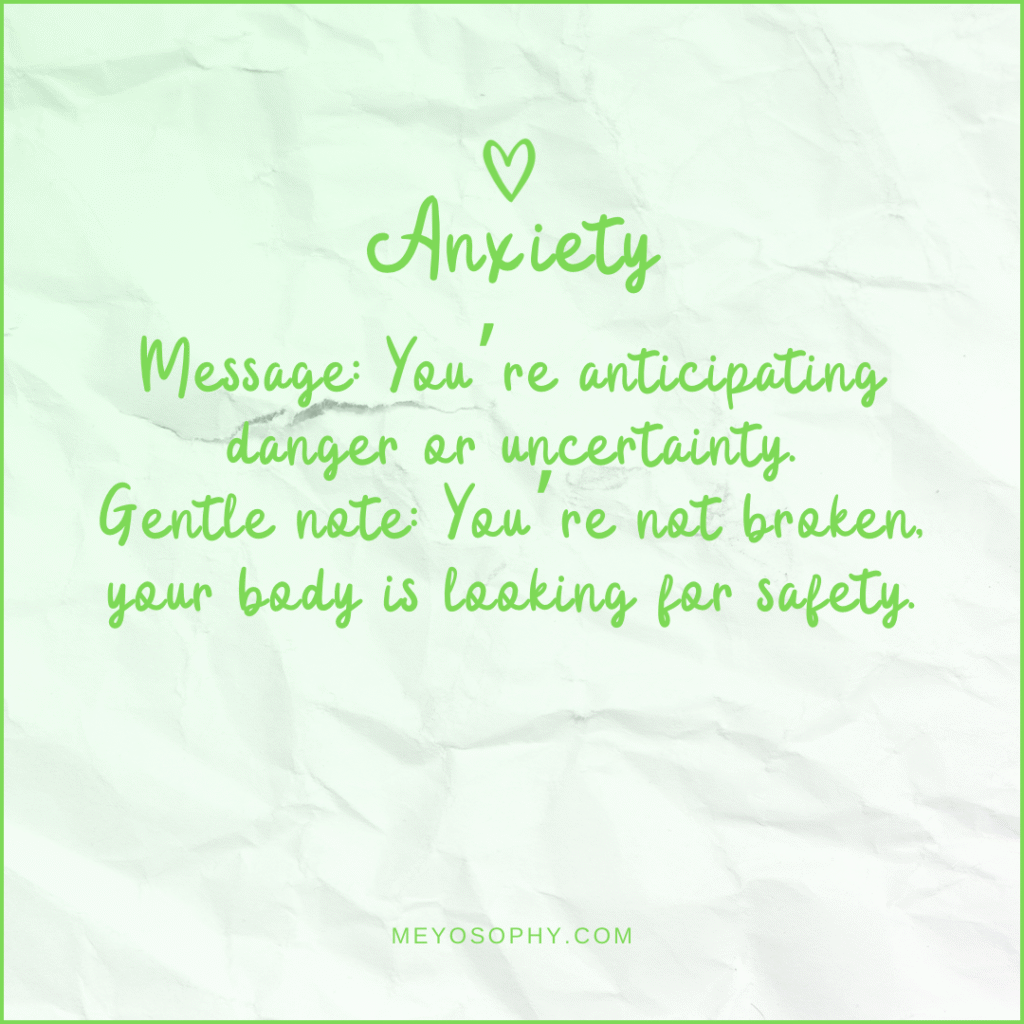
😊 Joy and Gratitude
Examples: happiness, peace, contentment, excitement, pride, satisfaction, amusement, relief, pleasure, wonder.
What it means: Joy shows you what lights you up. It often appears in small moments: sunlight on your face, laughter, connection.
What it needs: presence and sharing. Joy multiplies when you let yourself notice and savor it. It’s not something to chase, but something to allow. Gratitude however is something you can become more aware of to feel it more. Journalling is a great practice for being more gratefull.
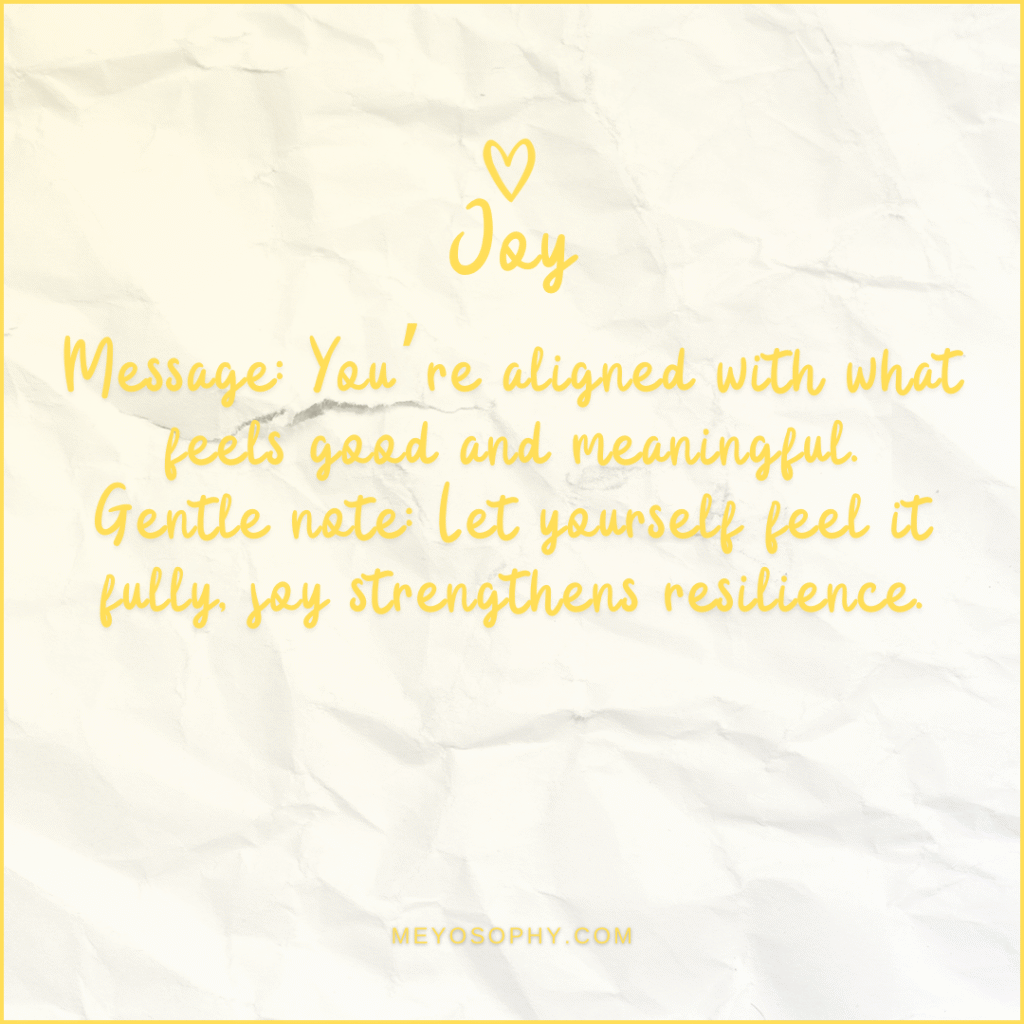
😳 Shame and Guilt
Examples: shame, embarrassment, guilt, regret, humiliation, inadequacy, remorse, self-blame.
What it means: These emotions help us reflect on our actions and relationships. Guilt says “I did something wrong.” Shame says “I am something wrong.” The first is repairable; the second needs compassion, not punishment.
What it needs: empathy, understanding, and self-forgiveness. Shame dissolves when met with kindness, often through safe connection or talking with someone who sees you fully.
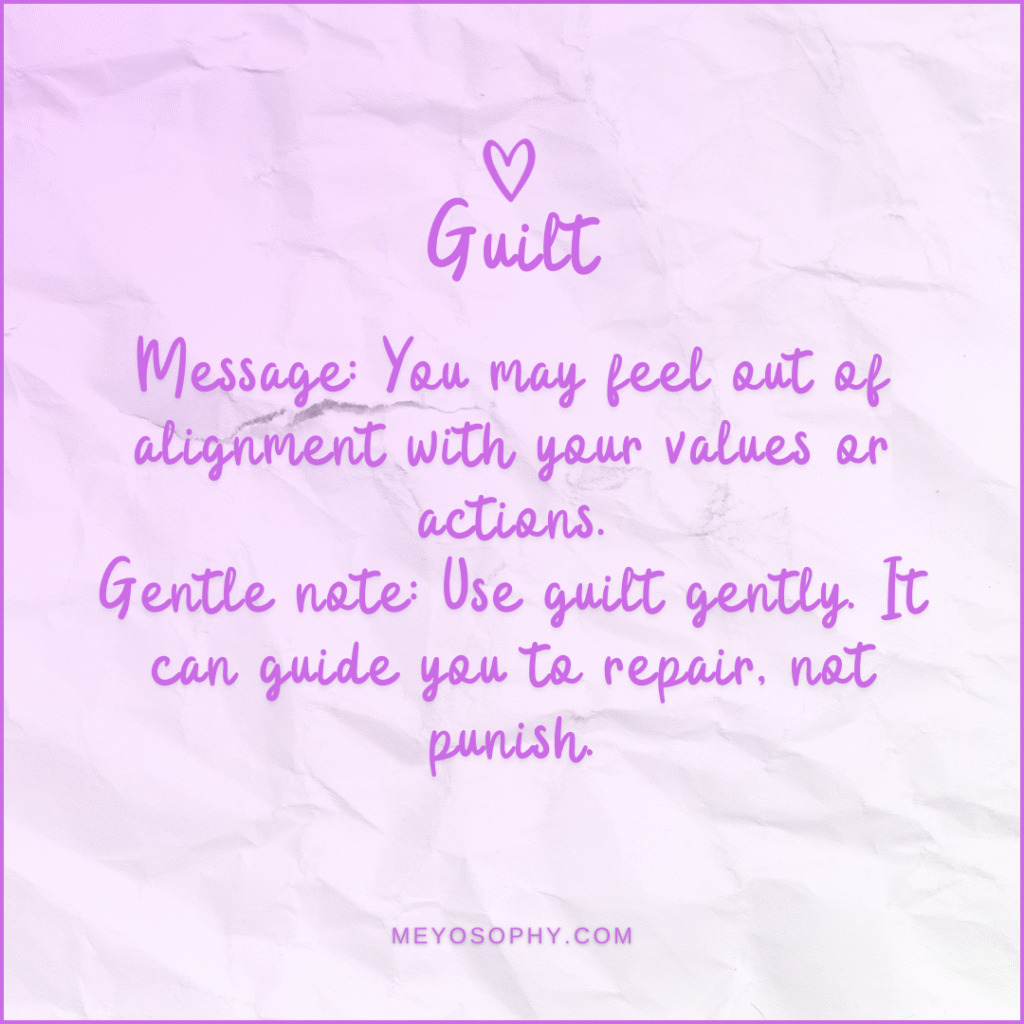
💞 Love and Connection
Examples: affection, trust, warmth, care, compassion, belonging, tenderness, appreciation, desire, admiration.
What it means: Love is the glue of human life. It’s not just romance, it’s the feeling of connection, safety, and shared meaning.
What it needs: expression, openness, and reciprocity. Letting yourself give and receive care strengthens your emotional system. Connection literally helps regulate your nervous system.
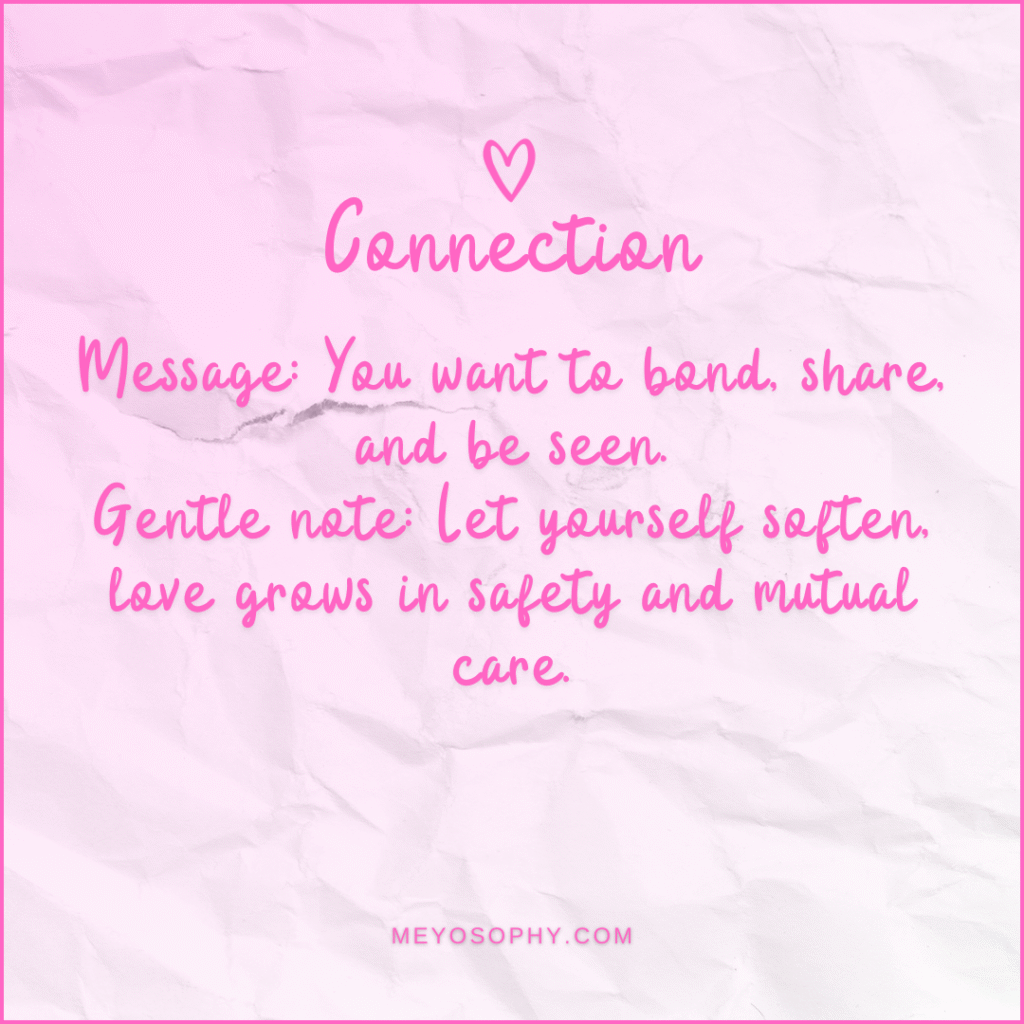
😤 Disgust and Rejection
Examples: disgust, aversion, contempt, repulsion, disapproval, judgment.
What it means: Disgust protects you from harm; physical, emotional, or moral. It signals when something feels “off” or unsafe to your integrity.
What it needs: boundaries and distance.
Instead of judging yourself for feeling disgust, try asking what your body is warning you about. Sometimes it points to a real value clash or toxic dynamic.
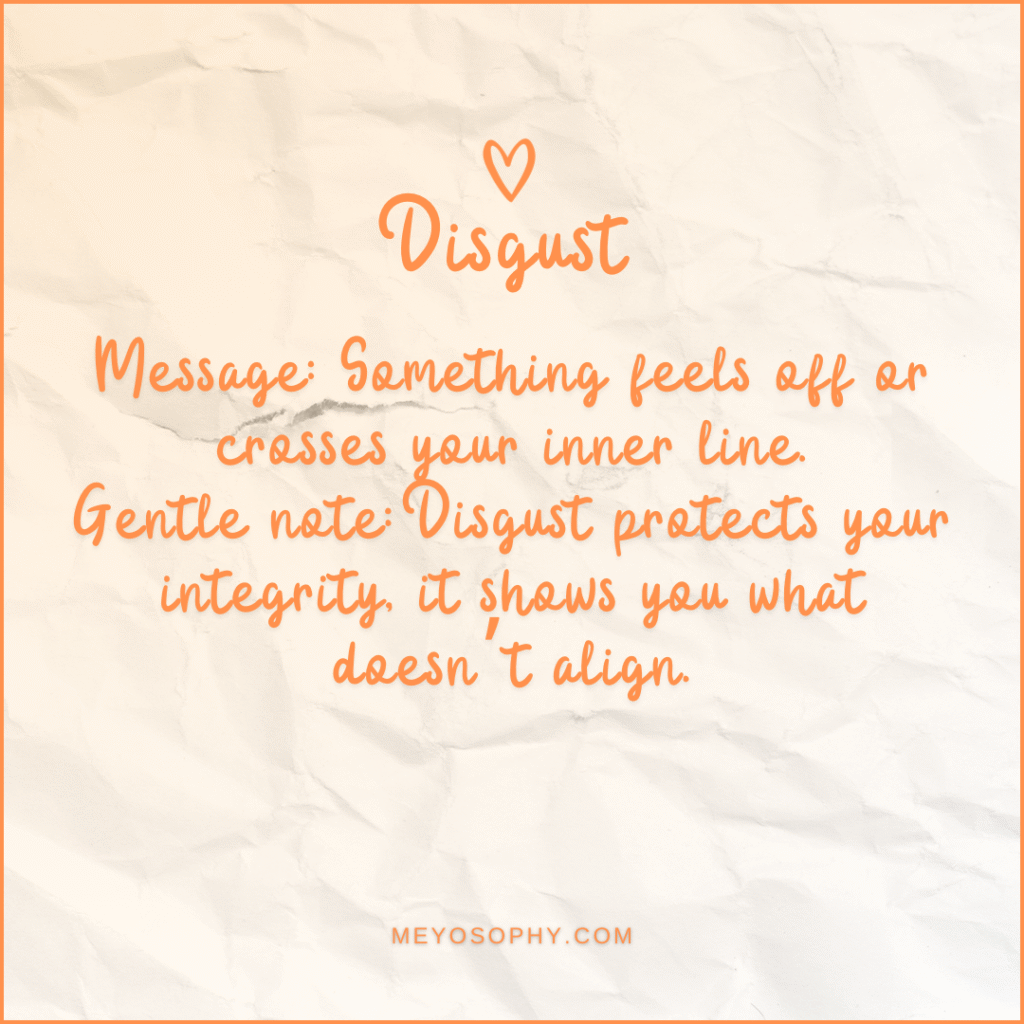
😶 Numbness and Disconnection
Examples: detached, indifferent, blank, foggy, hollow, disconnected, spaced out.
What it means: Emotional numbness is not the absence of emotion. It’s your nervous system in freeze mode, protecting you from overwhelm or pain.
What it needs: safety and gentle reawakening.
Try noticing sensations (warmth, pressure, breath) without forcing “feeling.” Over time, numbness softens when your brain trusts it’s safe to feel again.
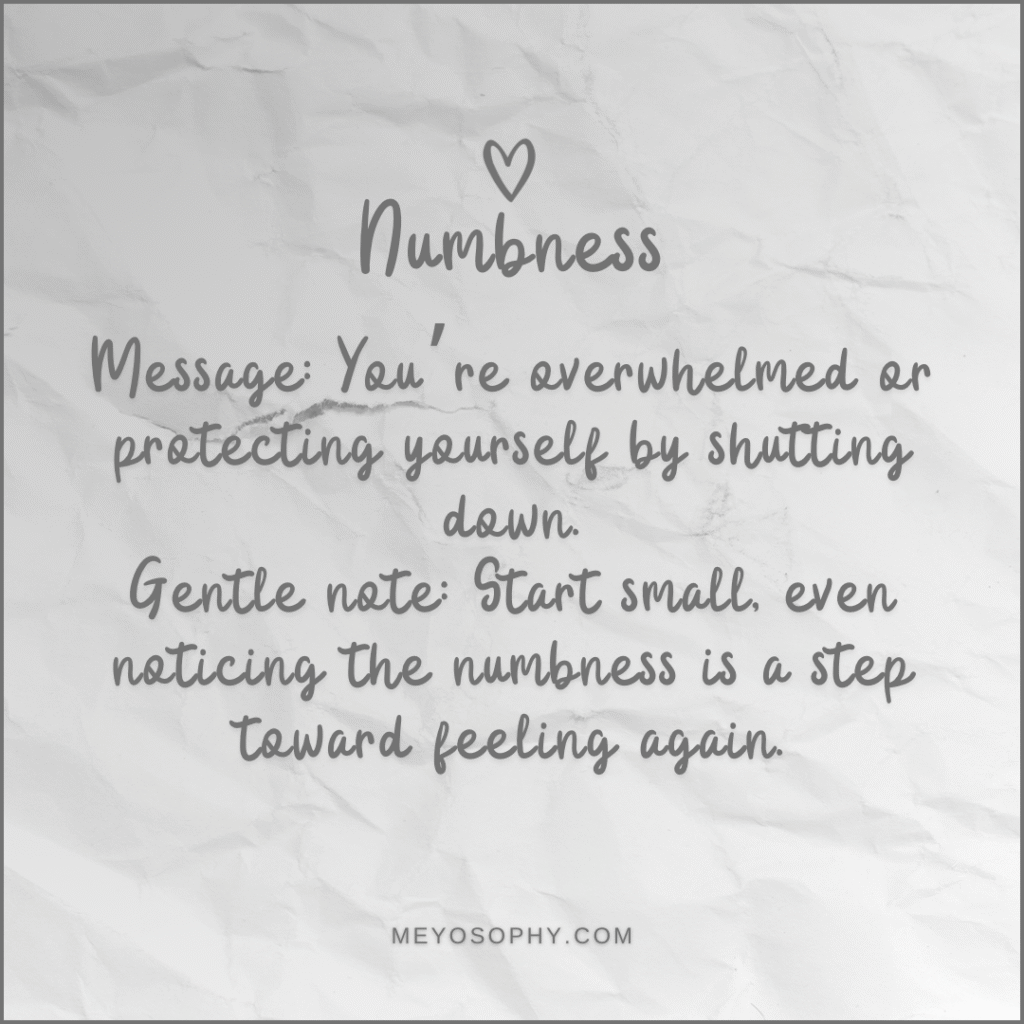
Mixed or Complex Emotions
Most of the time, we don’t feel one thing, we feel many things at once.
For example:
- You might feel relieved and sad after ending a relationship.
- Proud and terrified after starting therapy.
- Grateful and angry toward the same person.
Complex emotions mean you’re processing deeply, not failing at emotional clarity. It’s okay for feelings to contradict each other.
How to Identify What You’re Feeling
Here’s a simple practice you can use anytime, especially if emotions feel tangled or unclear.
1. Pause and check your body.
Where do you feel something: chest, stomach, throat, jaw? Emotions show up as sensations: tightness, heat, heaviness, tingling, or energy.
2. Describe the feeling physically.
For example: “My stomach feels tense” or “My chest feels heavy.” This grounds you before you jump to labeling.
3. Ask yourself: What’s happening right now?
Emotions are responses to situations. Think about what triggered your reaction: a memory, conversation, thought, or event.
4. Try naming one or two words.
You don’t need to be perfect. Guess if you’re unsure: “I think I feel anxious and lonely.” Notice if naming it gives you a small sense of relief.
5. Reflect on what that emotion might be asking for.
- Sadness → comfort or rest
- Anger → boundary or change
- Fear → reassurance or safety
- Joy → expression or sharing
Even if the emotion stays, you’ll feel less stuck inside it.
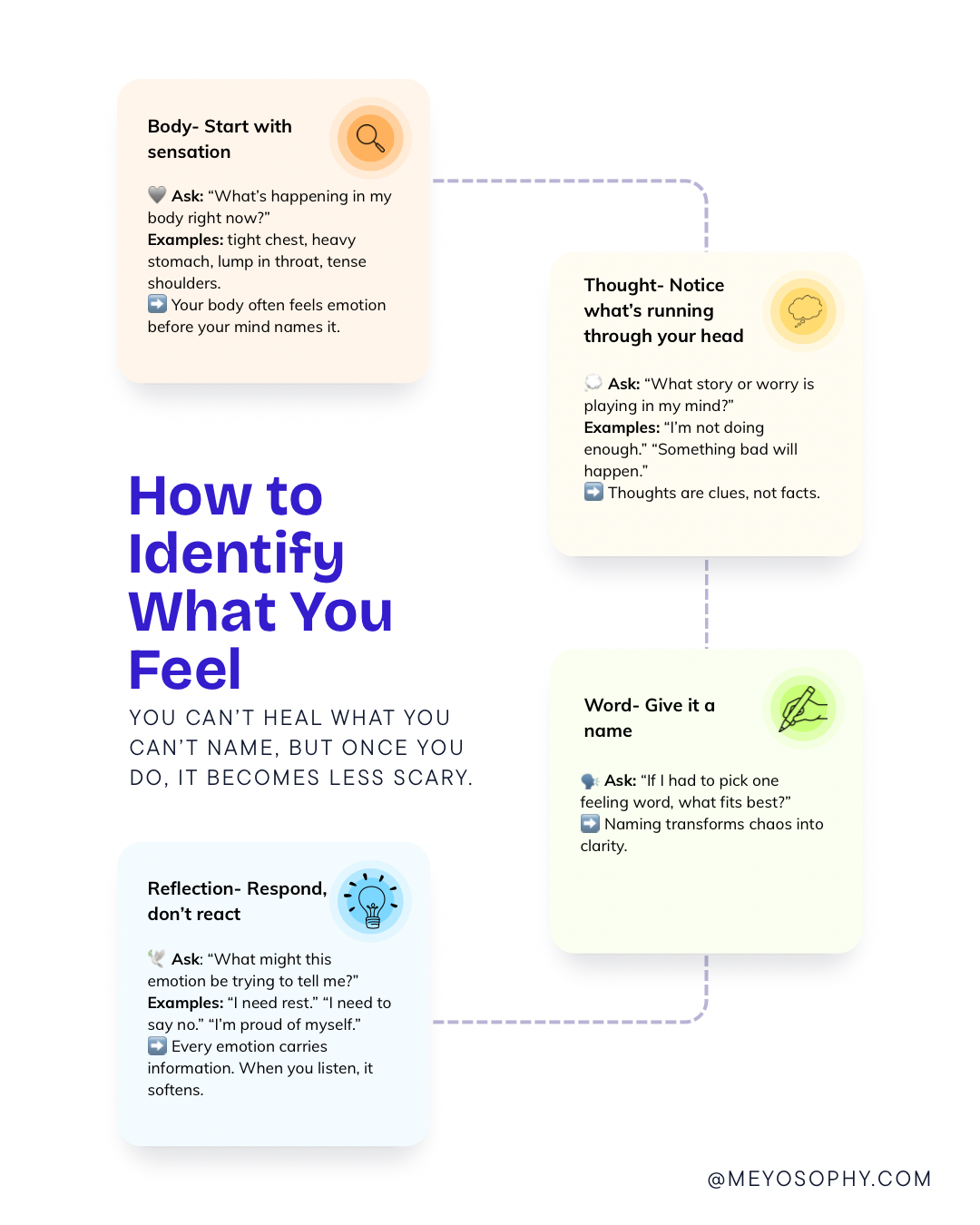
When You Feel Numb or Disconnected
Sometimes, the hardest thing is that you feel nothing at all.
That numbness can be part of depression, trauma, or derealization (a defense your brain uses to protect you from emotional overload).
If that’s you, start small. You can’t force feelings, but you can gently reconnect with your body and senses:
- Notice what you can see, hear, or touch right now.
- Place your hand over your heart or on your chest.
- Take one slow breath and feel the air move in and out.
- Say to yourself, “It’s safe to feel, even a little.”
Over time, these small check-ins rebuild the bridge between your body and emotions. You’ll start noticing flickers of feeling again.
How to Process and Release Emotions
Emotions are meant to move, not stay stuck inside. When we hold them in, they can build up as tension, fatigue, or even numbness. Processing your emotions doesn’t mean forcing yourself to feel everything all at once; it’s about giving your feelings gentle ways to flow through your body and out again.
Here are some simple, research-backed ways to help emotions move:
- Breathe through it: Slow, deep breaths tell your nervous system you’re safe, helping intense feelings settle.
- Write it out: Journaling, even for a few minutes, helps translate emotions into words, giving your brain clarity and relief.
- Move your body: Stretch, walk, dance, or shake it out. Physical movement helps release the energy emotions create.
- Talk it out: Share with someone you trust or a therapist. Naming feelings aloud makes them feel less heavy.
- Self-soothing touch: Place a hand over your heart or hug a pillow. Physical comfort signals safety to your body.
- Creative expression: Draw, sing, garden, or make something. Creativity helps emotions find another way out.
There’s no single “right” way to process emotions. What matters most is giving your feelings room to exist: safely, gently, and without judgment.
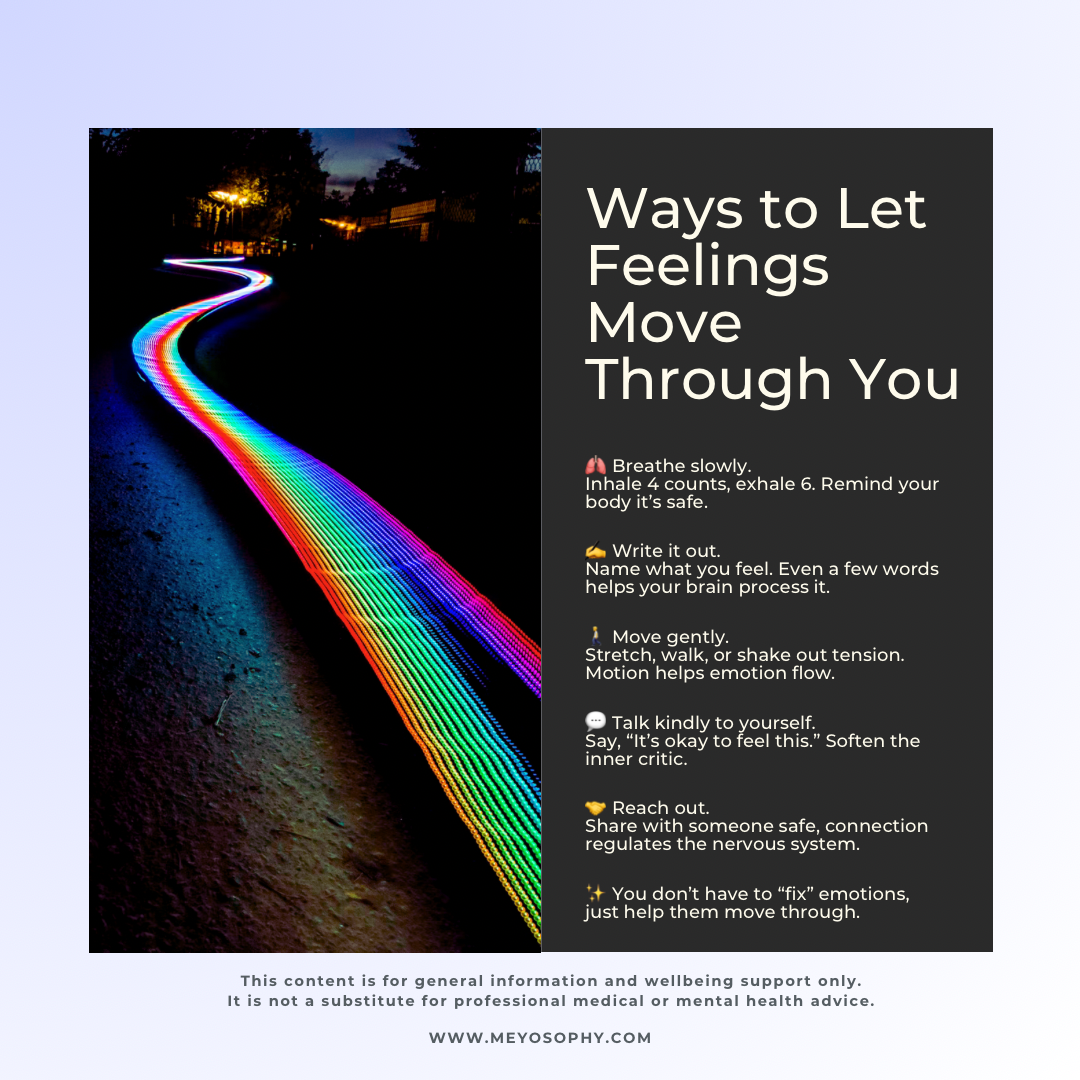
How to Practice Emotional Awareness Daily
- Use an emotion check-in: once or twice a day, pause and name one feeling you’ve had.
- Journal about what triggered it: “What happened before I felt this?”
- Use an emotion wheel or chart for vocabulary expansion.
- Talk about feelings out loud: with a friend, therapist, or even yourself.
- Pair emotions with compassion. Instead of “I shouldn’t feel this,” try “This feeling makes sense.”
You’re not trying to control emotions, you’re learning to listen to them.
When to Reach Out for Support
If your emotions feel too overwhelming, or if you’re stuck in sadness, emptiness, or anxiety for more than a couple of weeks, you don’t have to handle it alone.
Therapy can help you safely explore what you feel, learn emotional skills, and build a stronger sense of self. You are not a burden. You’re a person who’s learning to listen to yourself again and that’s something deeply brave.
If you ever feel unsafe with your thoughts or emotions, please reach out for immediate support through local emergency services or an international helpline such as findahelpline.com, which lists free and confidential options in your country. You don’t have to go through it alone.
Final Thoughts
Understanding your emotions isn’t about fixing yourself, it’s about coming home to yourself.
When you name what you feel (even something as small as “tired,” “restless,” or “hopeful”) you build emotional awareness, self-compassion, and a stronger connection to your life. The more you practice, the easier it becomes to see emotions not as enemies, but as gentle signals guiding you back to who you are.
Sources
- Lieberman, M. D. et al. (2007). Putting feelings into words: Affect labeling disrupts amygdala activity in response to affective stimuli. Psychological Science.
- Gross, J. J. (2015). Emotion regulation: Current status and future prospects. Psychological Inquiry.
- Barrett, L. F. (2017). How Emotions Are Made: The Secret Life of the Brain.
- Siegel, D. (2012). The Whole-Brain Child.
